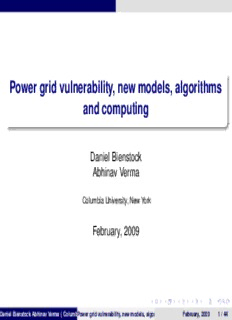
Power grid vulnerability, new models, algorithms and computing PDF
Preview Power grid vulnerability, new models, algorithms and computing
Power grid vulnerability, new models, algorithms and computing Daniel Bienstock Abhinav Verma ColumbiaUniversity,NewYork February, 2009 DanielBienstockAbhinavVerma(ColumbPiaoUwneirvgerrisditvy,uNlneewraYboilrikty),newmodels,algorithmsandcompFuetbinrugary,2009 1/44 Talk Outline Lossless power flows Solving the N-k problem A better model for the N-k problem DanielBienstockAbhinavVerma(ColumbPiaoUwneirvgerrisditvy,uNlneewraYboilrikty),newmodels,algorithmsandcompFuetbinrugary,2009 2/44 Power flow model - lossless model We are given a network with nodes N (“buses”) and arcs A (“lines”): A set of G of supply nodes (the “generators”); each generator i has an “operating range” 0 ≤ SL ≤ SU, i i A set D of demand nodes (the “loads”); for each load i a “maximum demand” 0 ≤ Dmax. i For each arc (i,j) a parameter x . ij Basic problem: operate network so as to maximize amount of delivered power DanielBienstockAbhinavVerma(ColumbPiaoUwneirvgerrisditvy,uNlneewraYboilrikty),newmodels,algorithmsandcompFuetbinrugary,2009 3/44 Power flow model - lossless model We are given a network with nodes N (“buses”) and arcs A (“lines”): A set of G of supply nodes (the “generators”); each generator i has an “operating range” 0 ≤ SL ≤ SU, i i A set D of demand nodes (the “loads”); for each load i a “maximum demand” 0 ≤ Dmax. i For each arc (i,j) a parameter x . ij Basic problem: operate network so as to maximize amount of delivered power DanielBienstockAbhinavVerma(ColumbPiaoUwneirvgerrisditvy,uNlneewraYboilrikty),newmodels,algorithmsandcompFuetbinrugary,2009 3/44 Power flow model - lossless model We are given a network with nodes N (“buses”) and arcs A (“lines”): A set of G of supply nodes (the “generators”); each generator i has an “operating range” 0 ≤ SL ≤ SU, i i A set D of demand nodes (the “loads”); for each load i a “maximum demand” 0 ≤ Dmax. i For each arc (i,j) a parameter x . ij Basic problem: operate network so as to maximize amount of delivered power DanielBienstockAbhinavVerma(ColumbPiaoUwneirvgerrisditvy,uNlneewraYboilrikty),newmodels,algorithmsandcompFuetbinrugary,2009 3/44 Power flow model - lossless model We are given a network with nodes N (“buses”) and arcs A (“lines”): A set of G of supply nodes (the “generators”); each generator i has an “operating range” 0 ≤ SL ≤ SU, i i A set D of demand nodes (the “loads”); for each load i a “maximum demand” 0 ≤ Dmax. i For each arc (i,j) a parameter x . ij Basic problem: operate network so as to maximize amount of delivered power DanielBienstockAbhinavVerma(ColumbPiaoUwneirvgerrisditvy,uNlneewraYboilrikty),newmodels,algorithmsandcompFuetbinrugary,2009 3/44 Feasible power flows Suppose we choose an output level b > 0 for each generator i, and i a demand level −b > 0 for each load i. i Write b = 0 for each other node i. i A power flow is a solution f, θ to: P P P f − f = b , for all i (so must assume b = 0) ij ij ij ji i i i x f − sin(θ − θ ) = 0, for all (i,j), (physics) ij ij i j | θ −θ | ≤ π (“stability”) i j 2 A difficult system? DanielBienstockAbhinavVerma(ColumbPiaoUwneirvgerrisditvy,uNlneewraYboilrikty),newmodels,algorithmsandcompFuetbinrugary,2009 4/44 Feasible power flows Suppose we choose an output level b > 0 for each generator i, and i a demand level −b > 0 for each load i. i Write b = 0 for each other node i. i A power flow is a solution f, θ to: P P P f − f = b , for all i (so must assume b = 0) ij ij ij ji i i i x f − sin(θ − θ ) = 0, for all (i,j), (physics) ij ij i j | θ −θ | ≤ π (“stability”) i j 2 A difficult system? DanielBienstockAbhinavVerma(ColumbPiaoUwneirvgerrisditvy,uNlneewraYboilrikty),newmodels,algorithmsandcompFuetbinrugary,2009 4/44 Feasible power flows Suppose we choose an output level b > 0 for each generator i, and i a demand level −b > 0 for each load i. i Write b = 0 for each other node i. i A power flow is a solution f, θ to: P P P f − f = b , for all i (so must assume b = 0) ij ij ij ji i i i x f − sin(θ − θ ) = 0, for all (i,j), (physics) ij ij i j | θ −θ | ≤ π (“stability”) i j 2 A difficult system? DanielBienstockAbhinavVerma(ColumbPiaoUwneirvgerrisditvy,uNlneewraYboilrikty),newmodels,algorithmsandcompFuetbinrugary,2009 4/44 Feasible power flows Suppose we choose an output level b > 0 for each generator i, and i a demand level −b > 0 for each load i. i Write b = 0 for each other node i. i A power flow is a solution f, θ to: P P P f − f = b , for all i (so must assume b = 0) ij ij ij ji i i i x f − sin(θ − θ ) = 0, for all (i,j), (physics) ij ij i j | θ −θ | ≤ π (“stability”) i j 2 A difficult system? DanielBienstockAbhinavVerma(ColumbPiaoUwneirvgerrisditvy,uNlneewraYboilrikty),newmodels,algorithmsandcompFuetbinrugary,2009 4/44
Description: